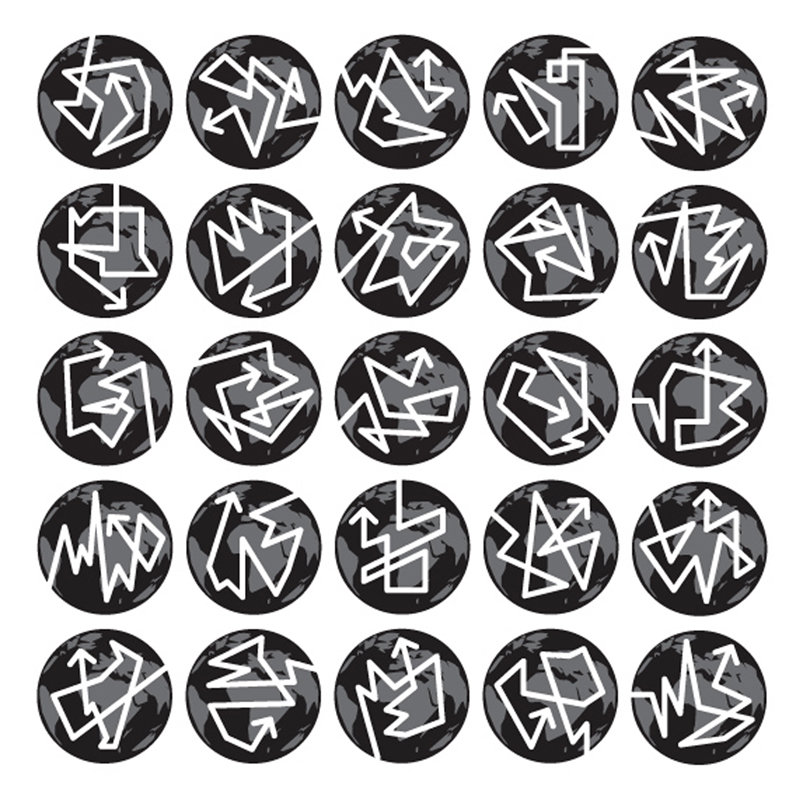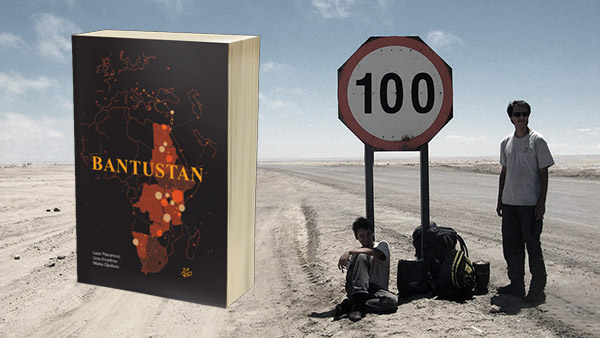
When asked what the new Travel Club identity should look like, I pondered it for a long time. We all did, for countless nights. For months. We gnawed at shoes, globes and maps, but all we could think of came down to banal tourist brochures or hiking clubs' logos. We wanted something more abstract, more powerful, unlike an ordinary, dead logotype.
Then I remembered a conversation I had when I wanted to buy a GPS device, and an old fantasy of mine that helped me fall asleep.

– So – she asks – what do you need the GPS for? Hiking?
– No – I say.
– Car?
– I can't drive.
– What then?
– For... drawing.
– Drawing?
When I have trouble falling asleep, I picture lines. Each and every step I've made, from my birth till today, each route of mine, each one of my travels leaves a trace on the surface of the planet. It's all recorded, coordinates are written down, longitudes and latitudes, peaks and azimuths, geotags, names of the cities, hamlets, gardens or kitchens, suburbs or antechambers, Pančevo, Asprovalta, Deliblato Sands and Portorož, Szeged, Moscow and Ulan Bator, Linz and Kigali, Burnaby, Hong Kong, El Nido, Pecs, Mostar, Köln and Dakar, Kotež, Sodara, Margita, Vojlovica and Hempmakers' Levy – all of these are being put down on a large map. With every house I ever entered, each highway, subway, byway, river bank, airplane or donkey, each incidental greeting, change of plans, premeditation, change of heart, hairpin curve, each collision and each encounter. The lines are precise to a milimeter. Thin. Broken. White lines on a round black surface. Thickening around South Banat, untangling further away, getting thinner, hemming in the globe's circle and disappearing into the oceans' folds. What do they look like?
Dead of the night, I still can't sleep. I picture the lines of my friends, parents, relatives, the lines of all people – dead, unborn, historical lines of migrations, encyclopaedias of lines, lines of every human's motion since the dawn of mankind, since we'd learned how to walk in the savannahs and rainforests of East Africa. The map is no longer zoomed in, the black globe slowly revolving in the aether, thick with white threads, looking like – what? A weaver bird's nest? A larva, a cocoon, an ordinary wriggle, a blot, a spider's catch? The dawn is cracking and I'm still struggling to picture it. Every journey is recorded there, since the creation up till today.
– And so – she says – you walk and the GPS records your route?
– Yes – I say. – It records geotags. That's how a drawing is formed.
– Why would you wanna record that? I mean, it's not like it's gonna be a nice drawing. Unless – she laughs – you walk through fields and people's back yards.
It's still night. Every life draws a line. Every encounter – a dot. The pencil stops for a moment, two hesitant lines are tied into a knot or separated or travel together for a while. New lines are being born, the old ones end in cemeteries resembling a chaos of cables around a router. When you look at a line you see a person's route. Their unique route. Jan Mayen, Srem, China, Antarctica, Macondo, Mecca, Gornji Milanovac, Prizren, Vladivostok.
It's morning, shadows of the blinds yawn on the ceiling, I touch the lines on the map with my eyes closed. A random human being in the darkness of history, unwittingly, draws a dog, a penguin, a horse, a coat of arms, an Arabic letter, a signature in Glagolitic alphabet or the constellation of Orion. What kind of a line does a life make, by pure chance?
And every night there are new lines, each one different. Like DNA. Each one unique.
– I'll draw – I say – Brownian motion.
– What motion? The thing with particles?
– Particles in a liquid, yes. They crash into other particles and stray. They draw zigzag lines – I look at her – just like us.
– And that's why you'll give 200 euros for a GPS?

That is what Lazar, Marko and I wrote while preparing for our African journey: Brownian collisions of human particles. That's what we wrote while planning any journey: there is no plan. You go from one dot to another, from one human being to another. The journey is born from random collisions – just like all journeys, since the arrival of human bipeds and their migrations.
When Monika, our designer, asked us about the final concept in order to make us a logo, when she asked us what The Travel Club really was, this is what we told her: Brownian motion. She drew the first lines. Remembering the long nights and the drawings I made walking with my GPS, I coded an algorithm that draws a new line, a new journey each time. Most of these lines were blurry and crumpled, so we chose the most beautiful ones – several hundred of them – and tuned the algorithm to draw these ones most of the times. Sometimes, however, a completely new, unrepeatable, random line is created. And our symbol became infinite, the journey itself.
That's how we set the tone for our new website: travels from a personal perspective, from the viewpoint of each individual person. Travels as a personal record of the world, a personal atlas. A waking map. An intimate database of the planet and its inhabitants, like that Mormon archive in the granite cliffs of Little Cottonwood Canyon outside Salt Lake City. Like Kiš's library:
Because – and that's I think the main message of the authors of the Encyclopaedia – nothing is ever repeated in the history of human beings, all that at first glance seems identical is hardly similar; each man is a star by himself, everything happens always and never, everything is repeated endlessly and unrepeatably. (That's why the authors of the Encyclopaedia of the Dead, that magnificent monument to diversity, insist on the personal, that's why each human being is sacred to them.)

